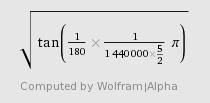"Castling" of harmonic equations @ http://www.wolframalpha.com/
We have input Bruce Cathie's original formulas into the wolframalpha math server and it shows there that the equations "should" be different:..
This is the original Harmonic 3 equations:
.png)
And this is the so-called "exact" stuff from WA:

The equations look similar but they are not identical. For one there is no reciprocal of 1 involved but rather the square-root of two, which is much more popular. Also that
we have the obvious multiplication by two in the beginning of the equation. Also it may explain the discrepancy between Cathie and The Establishment, no doubt that no-one before
us have bothered to do what we have done here; namely to find out if there are alternate ways of expressing Cathie's formulas.
We do not know what implications this has for the logic behind the evolution of the original equations, but for anyone that is more clever than us, that must be obvious.
This does maybe however link with what we wrote in Cathie-17 where we found that the E values derived could be reverse engineered again back into 3 different values, but that the values had to be
doubled.
A thing to notice is that our input as usual to wolfram alpha may have been wrong.
We are adding another nice stuff from WA:

equals....................:

so there is a relation between 1.440.000 (or 3.600.000 rather) and 648.000.000.
and another reason we put this here is that the resulting figure was: 0.0069628563211470787202408002049759057081565559603227...,if we test another harmonic value; exchange 648000000 for 162000000
(the previous divided by 2 twice) thus sqrt(tan(162000000)), we get 0.00013925712636838892. Both values seem like they could fit with the gravitational values listed in "The Harmonic Conquest of Space"
but both are lower than any of the values listed in the book..but the 1/x of the first give a value close to K' (speed of light at earth's surface in vacuum) at 36" with a difference of 0.3721290458342992.
Maybe the synergetics constants can help with fixing these values since we have seen that (1/(144*8))*(6**4)=1.125 which is one of the synergetics constants.
Ok, so we hope "Harmonic Equation 3" was input correct and that the output was in order. Next up is "Harmonic Equation 2":
 equals:
equals: .png)
Ok, that was "Harmonic Equation 2" next up is "Harmonic equation 1" which is the one we actually know something about (which is explain in the first Cathie article; the introduction), so it will
be interesting to see how...stuff..:
the original equation c+sqrt(1/c)*c^2, was then spat out as this: c+1/(1/c)^(3/2). 3/2 is a fraction as mentioned elsewhere here. However the double 1/(1/c) should cancel out so..
It does show however that all the stuff here may be in vain as we did not test "HE3" and "HE2" with actual data to check the output.
UPDATE. Tried quickly to test the two versions of HE2; the Cathie one and the one from WA. The seem to have given different output if we have done everything correct.
(C)1998 Teletypwriters Recombinati0n INSB. association.
INDEZ
 equals:
equals: .png)
.png)


